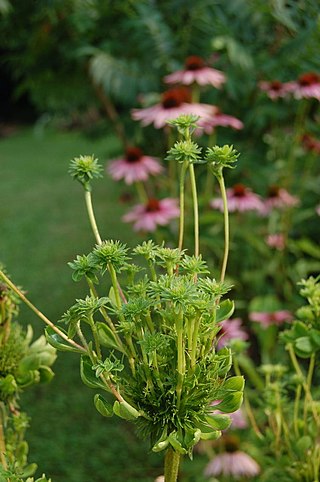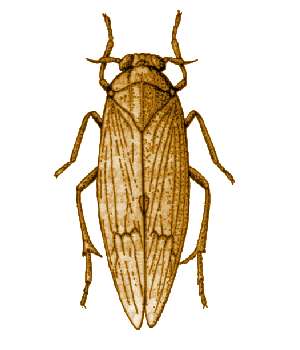Related Research Articles
Abau is a Papuan language spoken in southern Sandaun Province of Papua New Guinea, primarily along the border with Indonesia.
In botany and agriculture, stunting describes a plant disease that results in dwarfing and loss of vigor. It may be caused by infectious or noninfectious means. Stunted growth can affect foliage and crop yields, as well as eating quality in edible plants.

Phytoplasmas are obligate intracellular parasites of plant phloem tissue and of the insect vectors that are involved in their plant-to-plant transmission. Phytoplasmas were discovered in 1967 by Japanese scientists who termed them mycoplasma-like organisms. Since their discovery, phytoplasmas have resisted all attempts at in vitro culture in any cell-free medium; routine cultivation in an artificial medium thus remains a major challenge. Phytoplasmas are characterized by the lack of a cell wall, a pleiomorphic or filamentous shape, a diameter normally less than 1 μm, and a very small genome.

Acholeplasmataceae is a family of bacteria. It is the only family in the order Acholeplasmatales, placed in the class Mollicutes. The family comprises the genera Acholeplasma and Phytoplasma. Phytoplasma has the candidatus status, because members still could not be cultured.

Geminiviridae is a family of plant viruses that encode their genetic information on a circular genome of single-stranded (ss) DNA. There are 520 species in this family, assigned to 14 genera. Diseases associated with this family include: bright yellow mosaic, yellow mosaic, yellow mottle, leaf curling, stunting, streaks, reduced yields. They have single-stranded circular DNA genomes encoding genes that diverge in both directions from a virion strand origin of replication. According to the Baltimore classification they are considered class II viruses. It is the largest known family of single stranded DNA viruses.

A leafhopper is the common name for any species from the family Cicadellidae. These minute insects, colloquially known as hoppers, are plant feeders that suck plant sap from grass, shrubs, or trees. Their hind legs are modified for jumping, and are covered with hairs that facilitate the spreading of a secretion over their bodies that acts as a water repellent and carrier of pheromones. They undergo a partial metamorphosis, and have various host associations, varying from very generalized to very specific. Some species have a cosmopolitan distribution, or occur throughout the temperate and tropical regions. Some are pests or vectors of plant viruses and phytoplasmas. The family is distributed all over the world, and constitutes the second-largest hemipteran family, with at least 20,000 described species.

The brown planthopper (BPH), Nilaparvata lugens (Stål) is a planthopper species that feeds on rice plants. These insects are among the most important pests of rice, which is the major staple crop for about half the world's population. They damage rice directly through feeding and also by transmitting two viruses, rice ragged stunt virus and rice grassy stunt virus. Up to 60% yield loss is common in susceptible rice cultivars attacked by the insect. The BPH is distributed throughout Australia, Bangladesh, Bhutan, Burma (Myanmar), Cambodia, China, Fiji, India, Indonesia, Japan, North and South Korea, Laos, Malaysia, India, Nepal, Pakistan, Papua New Guinea, Philippines, Sri Lanka, Taiwan, Thailand, and Vietnam. Their alternative host plant other than rice is Leersia hexandra.

A planthopper is any insect in the infraorder Fulgoromorpha, in the suborder Auchenorrhyncha, a group exceeding 12,500 described species worldwide. The name comes from their remarkable resemblance to leaves and other plants of their environment and that they often "hop" for quick transportation in a similar way to that of grasshoppers. However, planthoppers generally walk very slowly. Distributed worldwide, all members of this group are plant-feeders, though few are considered pests. The infraorder contains only a single superfamily, Fulgoroidea. Fulgoroids are most reliably distinguished from the other Auchenorrhyncha by two features; the bifurcate ("Y"-shaped) anal vein in the forewing, and the thickened, three-segmented antennae, with a generally round or egg-shaped second segment (pedicel) that bears a fine filamentous arista.
Fiji disease virus (FDV) belongs to the reoviridae family and infects plants. It is one of the few plant viruses in the Reoviridae family. The type species of the genus Fijivirus, it is the only known member of Fijivirus group 1.
The 1998 Papua New Guinea earthquake occurred on July 17 with a moment magnitude of 7.0 and a maximum Mercalli intensity of VIII (Severe). The event occurred on a reverse fault near the north coast region of Papua New Guinea, 25 kilometers (16 mi) from the coast near Aitape, and caused a large undersea landslide which caused a tsunami that hit the coast, killing between at least 2,183 and 2,700 people and injuring thousands.
Rice hoja blanca tenuivirus (RHBV), meaning "white leaf rice virus", is a plant virus in the family Phenuiviridae. RHBV causes Hoja blanca disease (HBD), which affects the leaves of the rice plant Oryza sativa, stunting the growth of the plant or killing it altogether. RHBV is carried by an insect vector, Tagosodes orizicolus, a type of planthopper. The virus is found in South America, Mexico, throughout Central America, the Caribbean region, and the southern United States. In South America, the disease is endemic to Colombia, Venezuela, Ecuador, Peru, Suriname, French Guiana and Guyana.

Sugarcane mosaic virus (SCMV) is a plant pathogenic virus of the family Potyviridae. The virus was first noticed in Puerto Rico in 1916 and spread rapidly throughout the southern United States in the early 1920s. SCMV is of great concern because of the high economic impact it has on sugarcane and maize.

Sugarcane or sugar cane is a species of tall, perennial grass that is used for sugar production. The plants are 2–6 m (6–20 ft) tall with stout, jointed, fibrous stalks that are rich in sucrose, which accumulates in the stalk internodes. Sugarcanes belong to the grass family, Poaceae, an economically important flowering plant family that includes maize, wheat, rice, and sorghum, and many forage crops. It is native to the warm temperate and tropical regions of India, Southeast Asia, and New Guinea. The plant is also grown for biofuel production, especially in Brazil, as the canes can be used directly to produce ethyl alcohol (ethanol).
Eumetopina flavipes, the island sugarcane planthopper, is a species of planthopper present throughout South East Asia. E. flavipes is a vector for Ramu stunt disease, a plant disease which affects sugarcane. Ramu stunt disease is widespread throughout Papua New Guinea, but has not been detected in Australia.

Grapevine yellows (GY) are diseases associated to phytoplasmas that occur in many grape growing areas worldwide and are of still increasing significance. The most important grapevine yellows is flavescence dorée.
Texas Phoenix palm decline, or lethal bronzing, is a plant disease caused by a phytoplasma, Candidatus Phytoplasma palmae. It takes its name from the state it was first identified in and the palm genus, Phoenix, upon which it was first identified. It is currently found in parts of Florida and Texas.

Sugarcane grassy shoot disease (SCGS), is associated with ‘Candidatus Phytoplasma sacchari’ which are small, pleomorphic, pathogenic bacteria that contributes to yield losses from 5% up to 20% in sugarcane. These losses are higher in the ratoon crop. A higher incidence of SCGS has been recorded in some parts of Southeast Asia and India, resulting in 100% loss in cane yield and sugar production.
Papaya Bunchy Top Disease was first discovered in 1931 in Puerto Rico. Early on, the identity of the pathogen was highly contested due to the inability of isolating it; thus Koch’s postulates could not be fulfilled. Scientists have previously believed that Papaya Bunchy Top Disease was caused by a virus, a mycoplasma-like organism (MLO), or a phytoplasma, but these possible pathogens have since been disproven. Since the identity of the pathogen was unknown, all diagnoses were given solely based on a list of commonly associated symptoms. Through sequencing and microscopy, scientists identified the pathogen to be a part of the genus Rickettsia in 1996. The bacterium is described as being rod-shaped, small, gram-negative, and laticifer-inhibiting. Rickettsia causes diseases in animals, such as typhus and spotted fever, as well as in other plants, such as phony disease of peach and almond leaf scorch. Papaya Bunchy Top is found throughout the American tropics and has been economically important due to its major impact on fruit production. There is little information about the current economic impact.
Saccharum robustum, the robust cane, is a species of plant found in New Guinea.
References
- ↑ Detection by next generation sequencing of a multi-segmented viral genome from sugarcane associated with Ramu stunt disease. Mollov D, Maroon-Lango C and Kuniata L, Virus Genes, 2016 Feb, 52(1), pages 152-155, doi : 10.1007/s11262-015-1279-5
- ↑ The Phytoplasma Associated with Ramu Stunt Disease of Sugarcane Is Closely Related to the White Leaf Phytoplasma Group. C. P. R. Cronjé and R. A. Bailey, Plant disease, June 1999, Volume 83, Number 6, Page 588, doi : 10.1094/PDIS.1999.83.6.588A